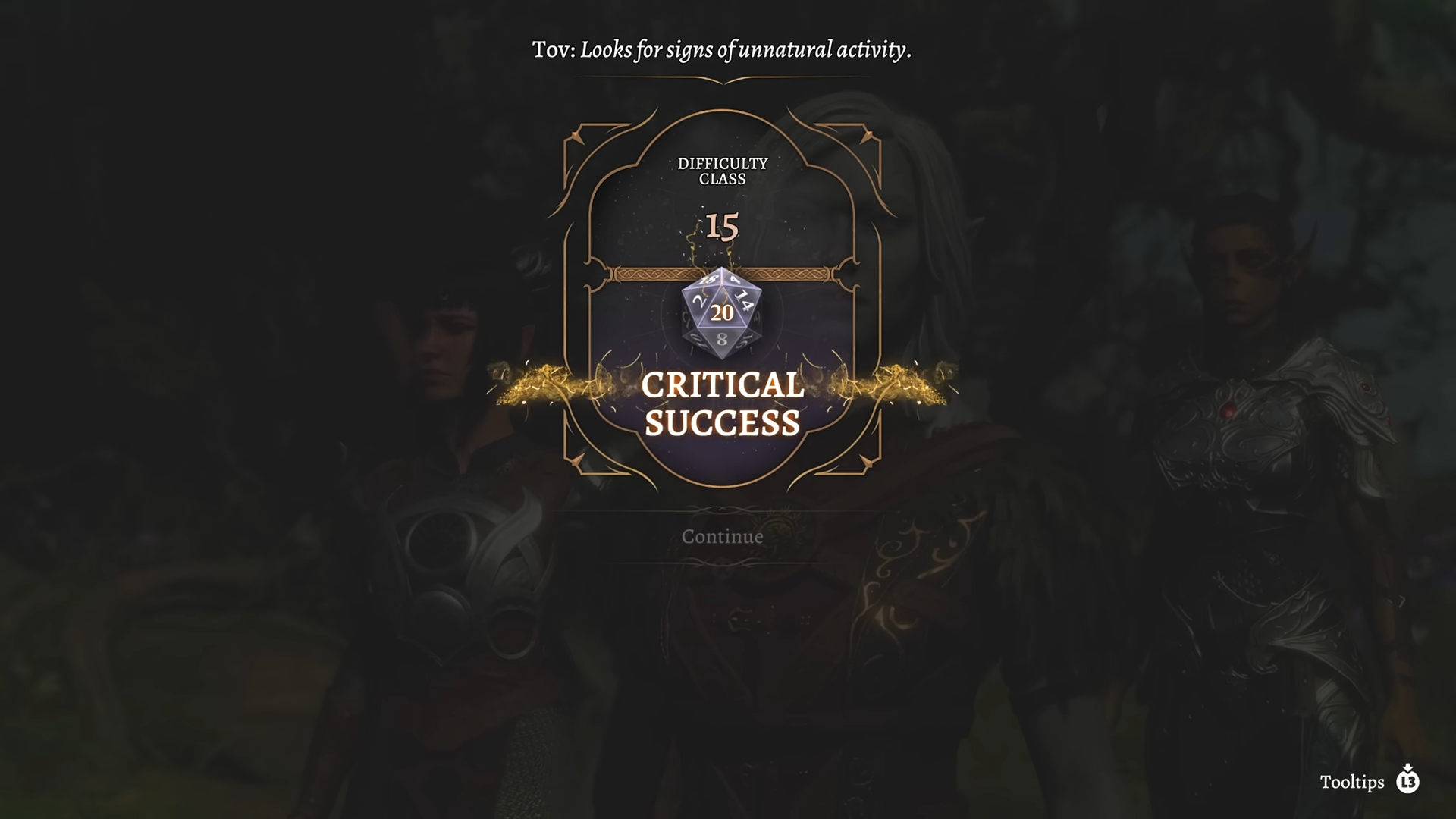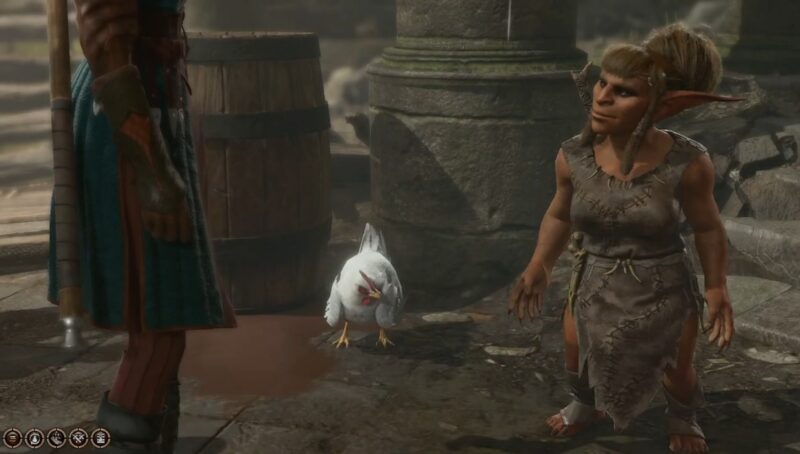This guide helps you create and roleplay the ultimate Custom Character in Baldur’s Gate 3. So you can shape your story with every choice.
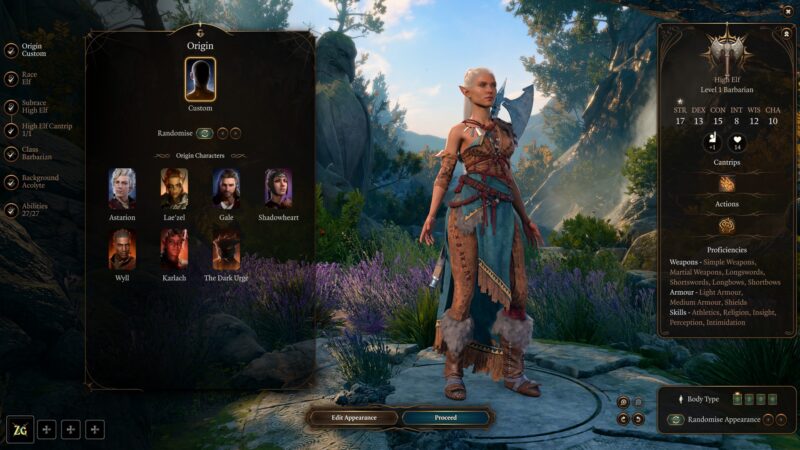
Baldur’s Gate 3 redefines the roleplaying genre by combining rich storytelling, tactical combat, and player-driven choices. Developed by Larian Studios, this epic adventure lets you journey through the Forgotten Realms with a party shaped by your decisions. Since every choice influences the world around you, the game rewards thoughtful exploration and strategic planning. Additionally, its foundation on Dungeons & Dragons 5e rules brings a layer of depth that makes each encounter feel unique and meaningful.
Playing as a Custom Character in Baldur’s Gate 3 provides you with the ability to create not only your look but also your values and story. As opposed to predetermined origin characters, a custom Tav is a blank character at the start, and so you can define your background, class, and alignment according to your preferred method of play. Therefore, what you do influences dialogue, the success or failure of quests, and even companions’ responses towards you. Additionally, creating a Custom Character in Baldur’s Gate 3 provides room for roleplay, as your choices mirror your character’s personality at every decision. Ultimately, the decisions you make with your custom Tav really make your own special journey through the game.
- Choosing Your Fantasy Custom Character In Baldur’s Gate 3
- A Brief Archetype List For Your Custom Character In Baldur’s Gate 3 With Roleplay Flavor + Mechanical Playstyle
- Consider A Backstory, Goals, And Flaws For Your Tav Roleplay
- How Background Affects Dialogue And Skill Proficiencies In Baldur’s Gate 3
- Class Breakdown By Roleplay Fantasy
- Dialogue, Alignment & Moral Choices For Your Character In Baldur’s Gate 3
- Tips On Using the “Inspiration” System To Reward Roleplay
- Multiclassing to Match the Personality Of Your Custom Character
- What is a Tav in Baldur’s Gate 3?
- Can Tav be fully customized in BG3?
- Do custom characters have their own story in Baldur’s Gate 3?
- Will I miss out on anything by not picking an Origin character in BG3?
A Guide to Tav Custom Character In Baldur’s Gate 3 and Origin Characters
In Baldur’s Gate 3, players can choose between premade origin characters or create a unique hero known as “Tav.” Origin characters come with rich backstories, predetermined motivations, and pre-written narrative arcs. Although these characters offer a strong sense of identity, they can sometimes limit your roleplaying flexibility. In contrast, a Custom Character in Baldur’s Gate 3 begins as a blank slate, allowing you to define their appearance, background, personality, and moral outlook from the ground up.
Interestingly, the name “Tav” originates from Larian Studios’ internal placeholder for unnamed protagonists—it eventually became the default name used for any Custom Character in Baldur’s Gate 3. Because a custom Tav offers unparalleled freedom, it can lead to a more immersive and personal storytelling experience. You’re not tied to a specific past, which means you can react to the world based entirely on how you imagine your Tav would think or feel.
Additionally, custom Tavs allow for greater flexibility in character builds, letting you balance fantasy and gameplay needs with ease. As a result, this guide will help you create a Custom Character in Baldur’s Gate 3 that not only fits your narrative vision but also performs well in combat, dialogue, and exploration.
Choosing Your Fantasy Custom Character In Baldur’s Gate 3
Choosing your fantasy Custom Character in Baldur’s Gate 3 is one of the most exciting parts of the game. Whether you envision a noble paladin bound by honor or a mischievous rogue who bends the rules, the game gives you the tools to bring that vision to life. Since a Custom Character in Baldur’s Gate 3 starts with a clean slate, you can shape every detail—from race and class to background and alignment—to match your ideal roleplay. Moreover, this freedom ensures that your journey feels personal, meaningful, and truly your own.
A Brief Archetype List For Your Custom Character In Baldur’s Gate 3 With Roleplay Flavor + Mechanical Playstyle
The Noble Knight
For players who want to lead with honor and discipline, the Noble Knight is a timeless archetype for a Custom Character in Baldur’s Gate 3. This role suits those who prefer a lawful good alignment, standing as a shield for the weak and a sword against chaos. Choosing the Oath of the Crown Paladin, introduced in Patch 8, lets your Tav embrace the values of law, loyalty, and protection. Moreover, this subclass empowers your Custom Character in Baldur’s Gate 3 with tactical abilities like Righteous Clarity to guide allies, Divine Allegiance to absorb damage, and interrupts that control the battlefield.
Alternatively, you can build your Custom Character in Baldur’s Gate 3 as a Battle Master Fighter, which replaces divine powers with precise combat techniques. Using Superiority Dice, the Battle Master executes maneuvers that trip enemies, defend allies, or disrupt enemy plans.
The Outcast Mage
For players who crave arcane power touched by danger, the Outcast Mage is a compelling archetype for your Custom Character in Baldur’s Gate 3. This build thrives on the fringes of society—misunderstood, feared, and incredibly powerful. Choosing the Shadow Magic Sorcerer allows your Tav to manipulate darkness itself. Thanks to Patch 8, this subclass grants Superior Darkvision, Shadow Walk, and Strength of the Grave, giving your Custom Character in Baldur’s Gate 3 both evasiveness and endurance. Furthermore, the Hound of Ill Omen lets you unleash a spectral predator to terrorize enemies, making it an excellent choice for players tackling Honour Mode or seeking a darker roleplay theme.
Alternatively, the Bladesinging Wizard offers a novel blend of sword combat and spellcasting. Instead of skulking in shadows, this mage waltzes through combat with agility and accuracy. Through Bladesong, your wizard has bonuses to speed, AC, and Constitution saves. In addition, Patch 8 adds to this subclass with new animations and casting flavor that add to immersion. Because a Custom Character in Baldur’s Gate 3 lets you tailor each aspect to your heart’s desire, the Outcast Mage archetype presents itself as a dramatic statement piece.
The Shadow Operative
For players who enjoy subterfuge, charm, and precision strikes, the Shadow Operative is a thrilling archetype for a Custom Character in Baldur’s Gate 3. This build blends stealth and sorcery, deception and deadliness, giving you the tools to manipulate any encounter. As a Hexblade Warlock, introduced in Patch 8, your Tav can form a pact with a mysterious Shadowfell entity. Not only can you curse your foes and drain their life essence, but you also gain access to powerful necrotic summons. Whenever you slay a valid target, their soul rises to fight beside you—damaging enemies and healing your Hexblade in return. As a result, your Custom Character in Baldur’s Gate 3 becomes both a hunter and a harvester of power.
However, if you prefer agility over arcane might, the Swashbuckler Rogue offers a bold, flashy alternative. This subclass brings a piratical flair to your Custom Character in Baldur’s Gate 3, adding stylish maneuvers like Disarming Attack, Sand Toss, and Fancy Footwork.
The Monster Hunter
If you imagine your Custom Character in Baldur’s Gate 3 as a relentless force against darkness, the Monster Hunter archetype delivers on every front. This build thrives on tracking, punishing, and outsmarting supernatural threats. Choosing the Death Domain Cleric, your Tav channels necrotic energy with a divine edge. Patch 8 introduced this subclass with three new necromantic cantrips and unique abilities like Toll the Dead, which deals scaling damage to wounded foes. Furthermore, the homebrewed option to detonate nearby corpses adds battlefield control and dark flavor. Therefore, your Custom Character in Baldur’s Gate 3 becomes a grim protector—one who turns death into a weapon.
Conversely, the Swarmkeeper Ranger presents a naturalistic but no less unsettling solution. This subclass allows your Custom Character in Baldur’s Gate 3 to command swarms of magical beasts that are both offense and mobility devices. Added in Patch 8, the swarms provide tactical advantages: Jellyfish shock with lightning, Moths blind with psychic damage, and Bees pierce the enemy while sending them flying back. Moreover, each swarm kind bestows teleportation, with the ability to creatively position itself in battle. Your Tav, as such, can manipulate the battlefield with accuracy and style. Whether as a grim god or the raw wilds themselves, the Monster Hunter is ready to confront monstrosities most would avoid.
The Silver-Tongued Trickster
For players who enjoy dazzling their foes and charming their way through challenges, the Silver-Tongued Trickster archetype fits perfectly. When you create a Custom Character in Baldur’s Gate 3, leaning into Charisma-based spellcasters like Bards and Sorcerers opens up both narrative freedom and mechanical versatility. The College of Glamour Bard, introduced in Patch 8, blends battlefield control with social manipulation. With Mantle of Inspiration, you grant allies temporary hit points while charming any enemy foolish enough to strike. Moreover, Mantle of Majesty lets you dominate charmed enemies—forcing them to flee, freeze, or drop weapons at your command. Consequently, your Custom Character in Baldur’s Gate 3 becomes both a protector and a puppet master.
Consider A Backstory, Goals, And Flaws For Your Tav Roleplay
When building your Custom Character in Baldur’s Gate 3, take a moment to explore who they truly are. What drives them forward? Which mistakes still haunt them? Although the game offers incredible freedom, a compelling backstory, personal goals, and meaningful flaws make every decision feel intentional. Even so, your Tav’s journey can shift based on the choices you make—so plan ahead, but stay open to change.
How Background Affects Dialogue And Skill Proficiencies In Baldur’s Gate 3
In Baldur’s Gate 3, your Custom Character’s background heavily influences both game and story. Every background, besides offering two necessary skill proficiencies, also allows for special dialogue options and modifies NPC interactions.
The Acolyte background, for instance, offers Insight and Religion, enabling your Tav to sense people’s emotions and comprehend holy affairs. This background improves roleplay, especially when combined with the Noble Knight archetype since they both emphasize following moral codes. It enables your character to set an example using righteousness, receiving the approval of those who look up to religion and wisdom.
Alternatively, the Charlatan background, providing Deception and Sleight of Hand, is ideal for characters who live off manipulation and deception. This background is ideal for the Shadow Operative archetype, which lives on deception, stealth, and cunning. Charlatan Tavs are great at convincing or fooling NPCs, paving the way for new opportunities. Likewise, this background fits the Swashbuckler Rogue, who employs both deception and agility to manipulate social interactions and outsmart foes.
Each background not only influences your Tav’s dialogue options but also determines how you approach skill checks, making your Custom Character in Baldur’s Gate 3 feel uniquely tailored. The right background choice ensures a more immersive experience, unlocking special interactions and gameplay opportunities.
Class Breakdown By Roleplay Fantasy
In Baldur’s Gate 3, creating a strong Custom Character requires careful class, race, and background choice. It not only determines your character’s powers but also adds depth to the role-playing experience. Below is a handpicked list of synergistic pairs.
Barbarian Class For Custom Character In Baldur’s Gate 3
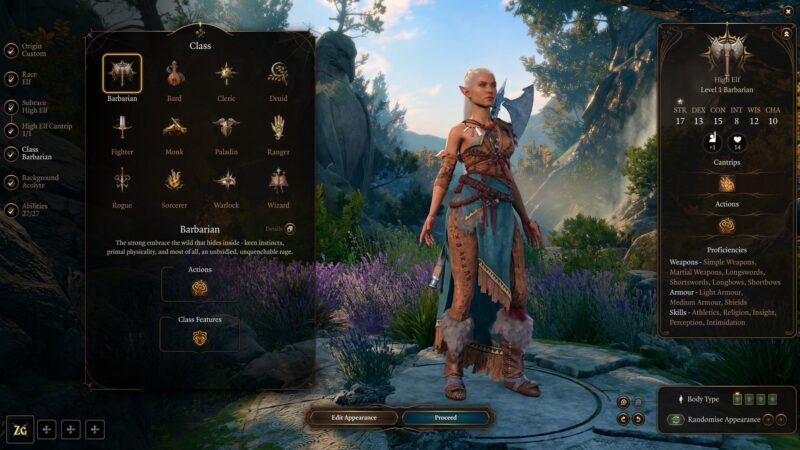
When creating a Custom Character in Baldur’s Gate 3, the Barbarian class thrives on raw strength and battlefield dominance.
- Race: Choosing Half-Orc amplifies your offensive potential, thanks to Attacks and Relentless Endurance. This race synergizes well with the Barbarian’s Rage, offering burst damage and survivability in equal measure.
- Background: Choosing the Outlander background enhances your untamed heritage. It provides expertise in Athletics and Survival, ideal for pursuing enemies and traversing the wilderness. These abilities usually unlock special dialogue lines and discovery options in woodland or isolated terrain.
- Roleplay: For a good roleplay, picture a tribal guardian banished to the Sword Coast, now in search of honor in combat. Whether you lean into the spirits of the ancestors of the Berserker or the fury of the elements of the Wildheart, your tale seems rooted in tradition and meaning.
- Gameplay: Mechanically, Barbarians have little to no armor and instead use Unarmored Defense and high Constitution. Using two-handed weapons such as the Greataxe or Maul maximizes your critical hits, particularly when enraged. Being a frontline bruiser, your job is to take a beating, break up enemy lines, and cleave through enemies with wild ferocity.
Bard Class For Custom Character In Baldur’s Gate 3
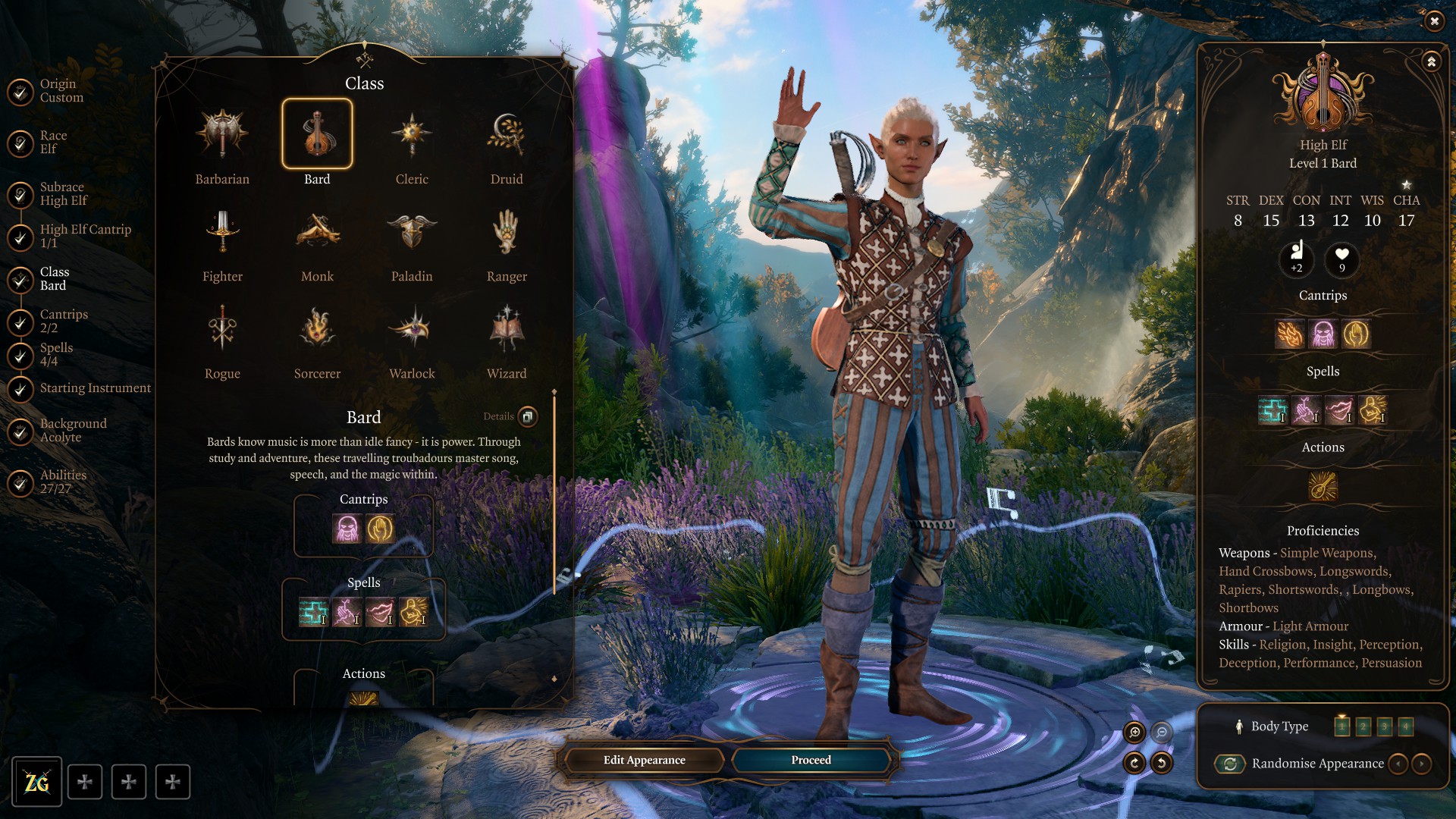
Creating a Custom Character in Baldur’s Gate 3 as a Bard means embracing versatility, charm, and control.
- Race: The High Elf race works exceptionally well, granting you an extra cantrip such as Minor Illusion, perfect for deceptive tactics or creative problem-solving in social encounters. Elves also benefit from Fey Ancestry, providing advantage on saving throws against being charmed—a trait that thematically aligns with many Bard subclasses.
- Background: Choosing the Entertainer background adds proficiency in Acrobatics and Performance, which enhances your dialogue choices during performances or tense negotiations. This combination supports a build that thrives in charisma-driven interactions and battlefield support.
- Roleplay: For roleplay, consider a traveling minstrel who hides deadly secrets behind a lute and a smile—ideal for the College of Glamour, introduced in Patch 8. This subclass offers Mantle of Inspiration, granting temporary hit points and repositioning allies without provoking opportunity attacks. Later, Mantle of Majesty allows you to cast Command as a bonus action, controlling enemies already charmed.
- Gameplay: Bards can wear light armor such as Studded Leather Armor or even The Wapira’s Crown, which grants healing bonuses. You’ll primarily wield finesse weapons like Rapier or Hand Crossbow, but your true power lies in spells like Dissonant Whispers, Hold Person, and Shatter—which deal damage while manipulating enemy positioning. Additionally, Inspiration Dice provide tactical flexibility, boosting allies’ rolls in critical moments.
Cleric Class For Custom Character In Baldur’s Gate 3
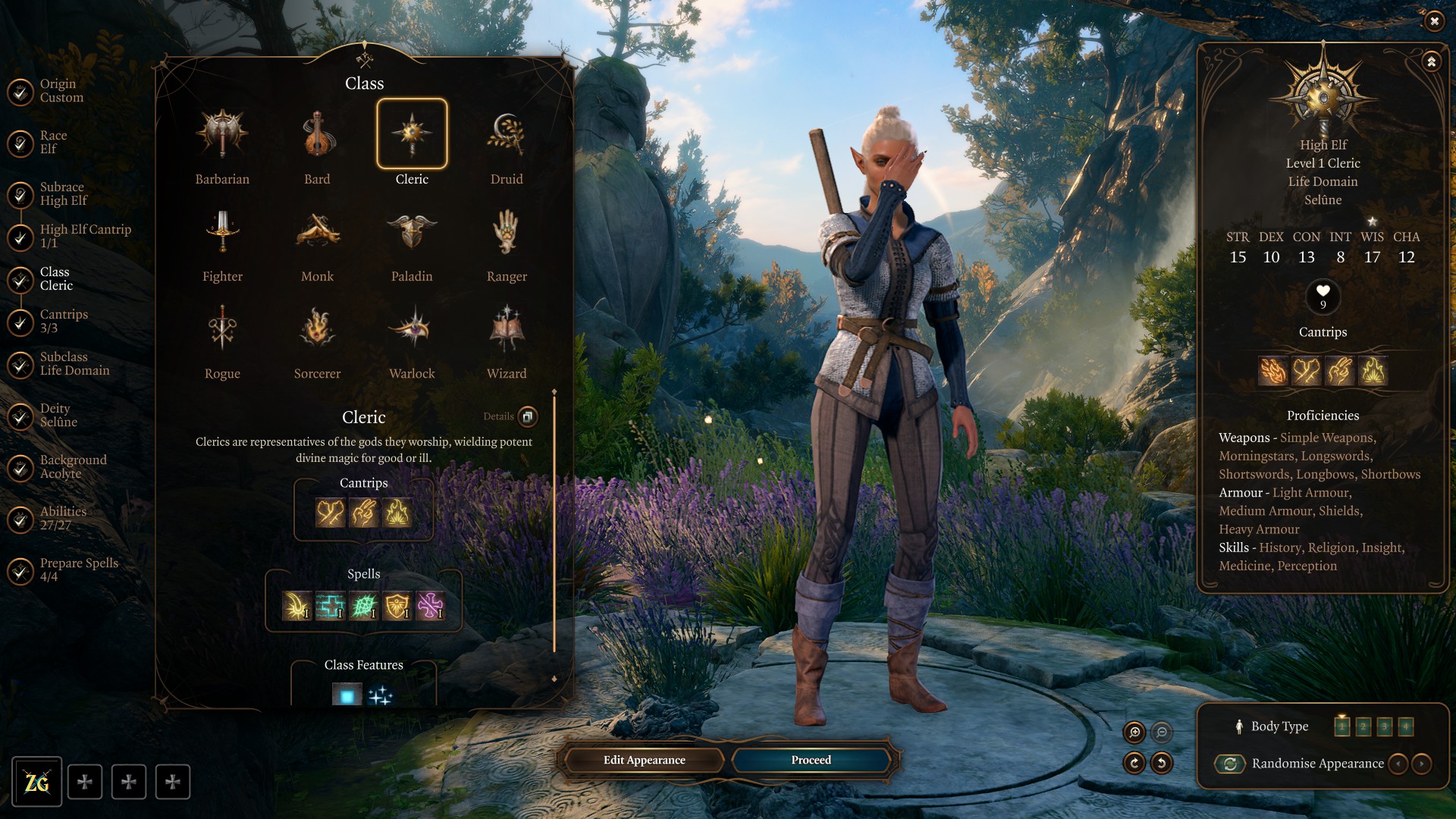
A Custom Character in Baldur’s Gate 3 who chooses the Cleric class becomes the party’s spiritual core—capable of restoring allies, punishing enemies, and anchoring the front line.
- Race: The Gold Dwarf race offers bonus hit points and Wisdom, enhancing both survivability and spell effectiveness. Additionally, Dwarven Resilience provides resistance to poison damage, which pairs well with close-range divine casters.
- Background: Selecting the Acolyte background complements the Cleric’s holy path, granting Insight and Religion proficiencies. These open up unique dialogue options when dealing with divine relics, cults, or ancient rituals, especially in places like the Gauntlet of Shar or Rosymorn Monastery.
- Roleplay: Roleplay-wise, imagine a steadfast servant of Selûne or Shar—perhaps torn between mercy and judgment. This concept fits exceptionally well with the Oath of the Crown Paladin multiclass or Cleric’s War Domain or Death Domain, the latter introduced in Patch 8. As a Death Domain Cleric, you gain Reaper, allowing you to cast necromancy cantrips like Toll the Dead on two targets simultaneously. Furthermore, unique abilities such as corpse detonation and necrotic bonuses empower a darker divine playstyle.
- Gameplay: Clerics wear medium armor like Chain Shirt +1 or Adamantine Scale Mail, and can wield shields and martial weapons. For instance, Justiciar’s Scimitar pairs perfectly with a War Cleric for bonus attacks. Spells like Spirit Guardians, Guiding Bolt, and Warding Bond grant both area control and single-target burst potential. Their Channel Divinity, especially in domains like Life or Trickery, can alter the flow of combat in a single action.
Clerics support the frontline, disrupt enemy formations, and deliver divine justice through versatile spellcasting and durability.
Druid Class For Custom Character In Baldur’s Gate 3
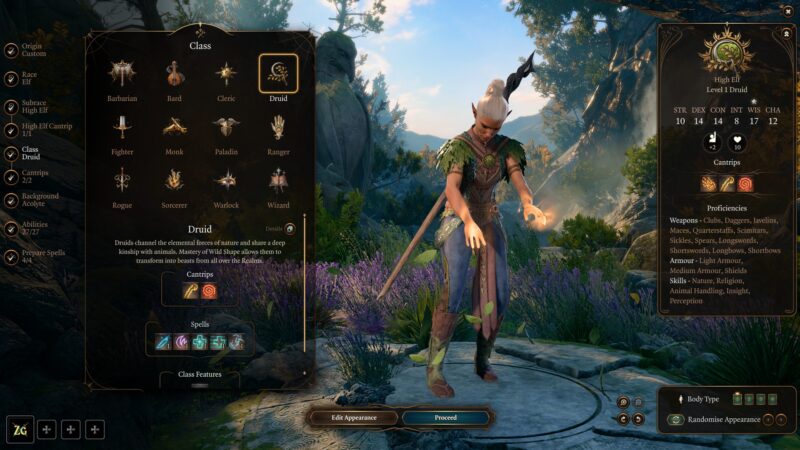
Creating a Custom Character in Baldur’s Gate 3 as a Druid offers a dynamic playstyle, blending spellcasting, shapeshifting, and battlefield control.
- Race: The Wood Elf race complements this class with increased movement speed, proficiency in stealth, and Fey Ancestry, granting advantage on saving throws against being charmed. Alternatively, the Duergar subrace provides superior darkvision and resilience against illusions and paralysis, enhancing survivability in subterranean encounters.
- Background: In backgrounds, the Hermit is an excellent match for the Druid’s lone relationship with nature, offering extra skill in Medicine and Religion, which is used to heal and interpret sacred rituals.
- Roleplay: Roleplay-wise, a Druid in Custom Character in Baldur’s Gate 3 could be a protector of the natural world, driven by a deep bond with the land, or someone who struggles with their shape-shifting abilities.
- Gameplay: In terms of gameplay, the Druid has great versatility, changing from role to role on demand. Tanking damage with Wild Shape or healing and crowd control with nature spells, they are a vital piece in any party setup. In battle, Druids offer awesome crowd control in the form of spells such as Entangle and Spike Growth, which are able to restrict movement in enemy units and manipulate the terrain to your benefit.
Fighter Class For Custom Character In Baldur’s Gate 3

For a Custom Character in Baldur’s Gate 3, the Fighter class is great at being versatile with a great mix of offense and defense.
- Race: Half-Orcs are an excellent race combination with Fighters because of their Savage Attacks trait, which enables them to deal additional damage on critical hits. Their Relentless trait is also advantageous, as they can continue fighting even after dropping to 0 hit points. Humans are also a good choice, with versatility through Versatile traits and Proficiency in All Armor, so they are well-suited to many combat roles.
- Background: Backgrounds like Soldier or Mercenary fit seamlessly with the Fighter class. The Soldier background provides proficiency in Athletics and Intimidation, key skills for maintaining control in combat and imposing your will on enemies.
- Roleplay: For roleplay, a character could be an ex-soldier seeking redemption or a mercenary working for gold but bound by a personal code.
- Gameplay: In terms of gameplay style, Fighters can specialize in damage dealing or tank-like roles. Equipped with weapons like Greatswords or Longswords and armor such as Plate Armor or Chain Mail, they can either focus on raw damage or absorb hits for their party. Their Action Surge ability offers additional combat actions, increasing their offensive potential during critical moments. With abilities like Second Wind (healing during battle), and their focus on Weapon Mastery in subclasses such as Battle Master or Champion, Fighters make reliable frontliners in both solo and party play. Whether acting as damage dealers or defenders, Fighters in Baldur’s Gate 3 provide consistent and reliable contributions in any battle scenario.
These were a few examples for class breakdown by roleplay fantasy in Custom Character in Baldur’s Gate 3. Each pairing enhances both gameplay and narrative, letting you fully embody your chosen fantasy in every encounter.
Dialogue, Alignment & Moral Choices For Your Character In Baldur’s Gate 3
In Baldur’s Gate 3, Tav’s decisions in dialogue, alignment, and moral choices shape their journey.
For instance, in the quest Hunt the Devil, the player can decide whether to assist or take advantage of Karlach. Assisting Karlach is in line with a more compassionate path, building party harmony, while taking advantage of her for self-interest results in a darker route.
For the Cult of the Absolute, Tav can either align with the faction and grant them power or resist their influence, which comes with challenges that require Tav to prove his integrity. An example is Shadowheart’s individual pursuit, where alignment with her during her turmoil or opposing her choices affects her loyalty and Tav’s adventure.
In terms of romantic interaction, the direction Tav moves can significantly impact their relationships. For example, in Karlach’s Romance, empathy makes her bond stronger and their relationship deeper, while using her for Tav’s purposes changes her image of Tav. Likewise, Shadowheart’s romance has a dynamic where manipulation and empathy both affect Tav’s alignment and path.
Tips On Using the “Inspiration” System To Reward Roleplay
In Baldur’s Gate 3, the Inspiration system compensates players for successfully fulfilling actions that correspond to their backgrounds. A Soldier may gain Inspiration, for instance, for commanding soldiers into combat. These activities, unique to each character’s background, award different levels of experience, ranging from 20 and going up to 275. This means that characters who gain Inspiration tend to get more experience than others since Inspiration is not party-shared.
Characters are able to develop and change over time, making surprising decisions that still reflect their fundamental values. For instance, a noble character may every now and then behave pragmatically, showing personal development. Always think about how your character would respond in the situation presented. Keep in mind that small thoughtful gestures can result in great rewards. Maintaining a balance between consistency and flexibility will maximize your character’s potential in the Inspiration system. Paying you back with both roleplaying satisfaction and in-game rewards.
Multiclassing to Match the Personality Of Your Custom Character
Multiclassing provides more expansive roleplay opportunity, mixing disparate abilities to suit a character’s particular background. A Paladin/Warlock is one of inner conflict, torn between divine duty and darkness. A Rogue/Bard may create performances while keeping secrets about a dark, hidden past. Druid/Sorcerer multiclassing ties an untamed mage to the ground, mixing primal and arcane abilities. Roleplay reasons for multiclassing provide depth of character, founded on internal struggle or individual growth.
Mechanically, multiclassing offers versatile abilities, though it can delay access to high-level class features. Balance roleplay motivations with gameplay benefits, ensuring character development aligns with your vision.
FAQs about Custom Character (Tav) in BG3?
What is a Tav in Baldur’s Gate 3?
Tav is the default name for your Custom Character in Baldur’s Gate 3. When you create your own protagonist instead of selecting an Origin character, the game refers to them as Tav.
Can Tav be fully customized in BG3?
Yes, Tav can be fully customized in Baldur’s Gate 3. You choose their race, such as Half-Orc or Tiefling, and their class, like Paladin or Sorcerer. You also select a background—Acolyte, Criminal, Sage, etc.—which affects roleplay and Inspiration gains. Additionally, you control appearance details like hairstyle, eye color, tattoos, and voice. Finally, you define Tav’s abilities, skill proficiencies, and even starting cantrips or fighting styles based on class.
Do custom characters have their own story in Baldur’s Gate 3?
Yes, custom characters—your Tav—have their own unique story in Baldur’s Gate 3. While they don’t have the predefined backstories of Origin characters, their narrative emerges through choices, relationships, and background-driven interactions. For example, a Folk Hero Tav may earn Inspiration by helping a desperate villager during the “Save the Refugees” quest. Dialogue options, moral decisions, and class-specific events dynamically shape Tav’s personal journey across all three acts.
Will I miss out on anything by not picking an Origin character in BG3?
You won’t miss core content by skipping an Origin character in Baldur’s Gate 3, but you will experience it differently. Origin characters like Astarion or Shadowheart come with personal quests—such as “The Pale Elf” or “Daughter of Darkness”—that unfold more intimately when you play as them. However, if you choose a Custom Character in Baldur’s Gate 3, you still engage with their stories as companions. Additionally, you gain the freedom to define your personality, backstory, and roleplay direction entirely, which many players find more immersive.
Looking For More About Baldur’s Gate 3?
Thank you for reading the Custom Character in Baldur’s Gate 3 guide. We provide the latest news and create guides for Baldur’s Gate 3. Also, watch me play games on Twitch or visit my YouTube channel!
 Reddit
Reddit
 Email
Email
